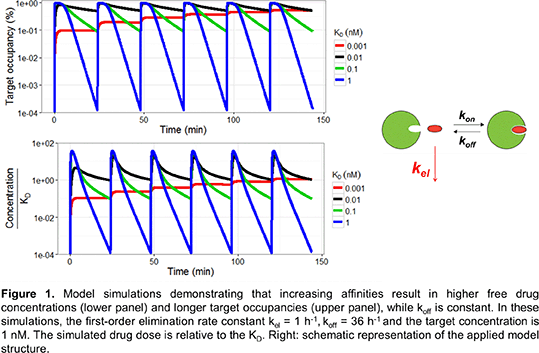| 159P London, UK Pharmacology 2016 |
When are drug-target binding kinetics relevant for drug discovery?
Introduction: Drug-target binding kinetics are fundamental properties that determine the relationship between drug exposure and target occupancy. Over the past decade, an interest has grown to include these drug properties in drug discovery screening (1). Although it is generally acknowledged that the relevance of binding kinetics in drug discovery is dependent on the drug and the target (2), a precise and quantitative understanding of the relation between its role and other pharmacological factors is lacking (3,4). Here, we use modeling and simulation techniques to acquire insight into the relation between binding kinetics, pharmacokinetics and target turnover.
Method: Mathematical models based on ordinary differential equations as commonly used to describe pharmacokinetics, drug-target binding kinetics and target turnover were used for simulations and mathematical analysis.
Results: As recently published, our first analysis reveals that both the drug-target association rate constant (kon) and drug-target dissociation rate constant (koff) can influence the duration of target binding, and that a high value of kon decreases the impact of koff (figure 1) (5). Moreover, if the degradation (and thus the turnover) rate of the target is high, the duration of target binding is hardly influenced by koff or kon. However, for fast target turnover, the extent of drug-target binding in equilibrium is influenced by kon, koff and the degradation rate of the drug-target complex, and not simply by KD (the ratio of koff and kon). This results in a decreased impact of koff on the extent of target occupancy in equilibrium. Algebraic expressions for the threshold values that determine the relevance of kon and koff were identified.
Conclusion: Factors such as pharmacokinetics and target turnover can both decrease and increase the impact of drug-target binding kinetics on the duration and extent of drug-target binding. These influences can be quantified by analyzing mathematical models of the relevant processes. A decreased impact for drug-target binding kinetics is expected for drugs with a high affinity and for targets with a high turnover rate.
References:
1. Copeland RA (2016). Nat Rev Drug Discov 15: 87-95.
2. de Witte WEA et al. (2015). Expert Opin Drug Discov 11: 45-63.
3. Dahl G and Akerud T (2013). Drug Discov Today 18: 697-707.
4. Vauquelin G (2016). Br J Pharmacol 173: 2319-2334.
5. de Witte WEA et al. (2016). Trends Pharmacol Sci: Epub ahead of print.
This work has received support from the EU/EFPIA Innovative Medicines Initiative Joint Undertaking, K4DD grant n° 115366.


